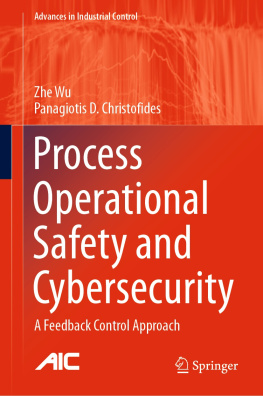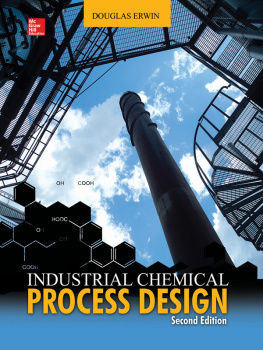Chemical Process Safety
Fundamentals with Applications
Fourth Edition
Daniel A. Crowl
Joseph F. Louvar
Boston Columbus New York San Francisco Amsterdam Cape Town
Dubai London Madrid Milan Munich Paris Montreal Toronto Delhi Mexico City
So Paulo Sydney Hong Kong Seoul Singapore Taipei Tokyo
Many of the designations used by manufacturers and sellers to distinguish their products are claimed as trademarks. Where those designations appear in this book, and the publisher was aware of a trademark claim, the designations have been printed with initial capital letters or in all capitals.
The authors and publisher have taken care in the preparation of this book, but make no expressed or implied warranty of any kind and assume no responsibility for errors or omissions. No liability is assumed for incidental or consequential damages in connection with or arising out of the use of the information or programs contained herein.
For information about buying this title in bulk quantities, or for special sales opportunities (which may include electronic versions; custom cover designs; and content particular to your business, training goals, marketing focus, or branding interests), please contact our corporate sales department at or (800) 382-3419.
For government sales inquiries, please contact .
For questions about sales outside the U.S., please contact .
Visit us on the Web: informit.com
Library of Congress Control Number: 2019930097
Copyright 2019 Pearson Education, Inc.
Cover image: Travel Mania/Shutterstock
All rights reserved. This publication is protected by copyright, and permission must be obtained from the publisher prior to any prohibited reproduction, storage in a retrieval system, or transmission in any form or by any means, electronic, mechanical, photocopying, recording, or likewise. For information regarding permissions, request forms and the appropriate contacts within the Pearson Education Global Rights & Permissions Department, please visit www.pearson.com/permissions/.
ISBN-13: 978-0-13-485777-0
ISBN-10: 0-13-485777-1
ScoutAutomatedPrintCode
3 20
Preface
We are pleased and delighted to offer the fourth edition of our textbook on chemical process safety. It is amazing to us that our original concept from the late 1980sto produce a process safety textbook for undergraduates that reflects industrial practicestill endures and is just as valuable today as when we first envisioned this resource.
For most traditional chemical engineering coursessuch as stoichiometry or thermodynamicsthe technical content has been well established for many years. This is not the case for process safety, which remains a dynamically evolving field. This ever-changing nature presented an enormous challenge to us when we sought to update our text to match current technology and industrial practice.
All textbooks have several requirements. First, the content must be of value to the student or reader and must be presented in a clear and well-organized fashion. Second, the content must develop progressively, working from what the student knows to what the student doesnt know. Third, the content must be active, with lots of worked examples, figures, and tables. In our case, the textbook must also reflect industrial practice. These requirements are not easy to achieve, but we have strived to meet them in all editions of our text.
The first edition of our text was published in 1990. The main effort with the first edition was to develop a workable outlinewhich took a considerable effort because what we proposed had never been done before. Once the outline was developed, we then needed to collect the technical content from industry and modify and organize it for student instruction.
The second edition was published in 2002. This text was primarily an incremental edition with content additions that we realized were missing in the first edition. In particular, we added new content on flammability, primarily on the use of the flammability triangle diagrams and how they are applied to estimate target concentrations.
The third edition was published in 2011. This edition added a new chapter on chemical reactivitywhich really should have been included in the first edition. The major development here was to recast the theoretical model into dimensionless form to simplify the equations for student manageability. We also continued our efforts to update the text to current industry practice.
The fourth edition was a major challenge. Process safety technology and industrial practice had changed substantially since the publication of the third edition. This resulted in a major overhaul of the entire text. Several chapters were completely rewritten, and all chapters had major modifications. We also removed some content that we deemed to be of lesser value since we wanted to reduce the page count. This removed content is still available for instructors on the Pearson Instructor Resource Center (https://www.pearson.com/us/higher-education/subject-catalog/download-instructor-resources.html).
In the first three editions, we developed new homework problems for each edition, with the result that the third edition contained more than 100 pages of homework. We decided to reduce the homework content significantly with the fourth edition, since homework appears to have less value in todays teaching environment. The 100 pages of homework from previous editions remains available for instructors on the Pearson Instructor Resource Center (https://www.pearson.com/us/higher-education/subject-catalog/download-instructor-resources.html).
Acknowledgments
We have an enormous number of people to thank for helping us with the fourth and previous editions. As the saying goes, We stand on the shoulders of giants.
Many of the folks who assisted with previous editions have passed away, including Trevor Kletz, Gerry Boicourt, Jack Wehman, Walt Howard, Stan Grossel, Reid Welker, Charles Springer, and Ron Darby.
For this fourth edition, we thank Ray Mentzer and Ken First, who served as technical reviewers. Both Ray and Ken have both industrial and teaching experience, so their edits were very helpful, and served as a compass for our work.







